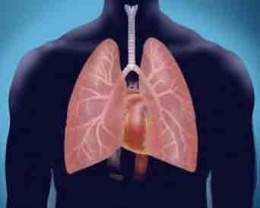It is an inflammation of the lower airways. It happens when the bronchial tubes, located between the lungs , become inflamed due to an infection or some other cause. According to its duration and etiology, a distinction is made between acute bronchitis, of short duration, and chronic bronchitis, of long duration and with frequent relapses.

Symptoms
- Coughing up mucus, sometimes bloody. If the mucus from bronchitis is yellowish-green and accompanied by a fever , it is most likely a bacterial infection.
- Inflammation of the bronchi (branches of the airways between the trachea and the lungs ).
- Inflammation ( edema ) of the bronchial walls.
- Alveoli obstruction.
- Beeping or wheezing.
- Bubbling (referring to the sound effect seen when the patient is listened to with a stethoscope).
- Shortness of breath
- General discomfort.
- Fatigue .
- Fever , usually low.
- Shortness of breath aggravated by exertion or mild activity.
- Wheeze .
Even after acute bronchitis has resolved, a dry, bothersome cough may develop that lasts for several weeks.
Causes of bronchitis
The main cause of chronic bronchitis is smoking. Cigarette smoke causes this mucus-producing cells to multiply and attacks the hair cells responsible for moving mucus into the mouth. The inflammation of the walls of the bronchus is the great irritation caused by this smoke. In fact, people who come from smoking households are more likely to develop chronic bronchitis. The environmental pollution is the factor that is next in importance to cigarette smoke. Pollution, dust and irritating gases that are part of this air pollution can also cause chronic bronchitis, this is especially true for large cities, in industrial areas.
Tests and exams
The doctor will listen to the lungs with a stethoscope. Noises can be heard in the lungs called rales or other abnormal breath sounds.
- Chest X-ray .
- Pulmonary function tests provide useful information for making the diagnosis and prognosis .
- A pulse oximetry helps determine the amount of oxygen in the blood. This quick, painless test uses a device that fits over the finger. Arterial blood gases are a more accurate measure of oxygen and carbon dioxide levels , but it requires a needle stick and is more painful.
- Sputum samples can be taken to check for signs of inflammation or bacterial infection.
Forecast
In acute bronchitis, symptoms usually clear up in 7-10 days if one does not have an underlying lung disorder; however, a dry, bothersome cough can last for many months.
The chance of recovery is low in people with advanced chronic bronchitis. Prompt diagnosis and treatment, along with quitting smoking, significantly improve the chance of a good prognosis .
Treatment
Antibiotics are not needed for acute bronchitis caused by a virus. The infection usually clears up on its own within a week. Take the following steps to achieve some relief:
- No Smoking.
- Drink a lot of liquid.
- Rest.
- Take acetylsalicylic acid ( aspirin ) or acetaminophen (Tylenol) if you have a fever . The first should not be given to children.
- Use a humidifier or steam in the bathroom.
If symptoms do not improve, your doctor may prescribe an inhaler to open your airways if you are wheezing. If your doctor thinks you have a secondary bacterial infection, he or she may prescribe antibiotics. Most of the time, antibiotics are not needed or recommended.
In the case of any bronchitis, the most important step one can take is to STOP smoking. If bronchitis is caught early, damage to the lungs can be prevented.
Medications for treatment
Contact a doctor for screening and prevention of bronchitis
- Bronchodilators : These are drugs that act by preventing and controlling the closure of the wall of the bronchus (bronchospasm). Currently it is preferred to administer them in aerosols .
- Corticosteroids : They are also used as a resource in patients with chronic bronchitis, due to their anti-inflammatory action associated with bronchodilators. Example: Decadron , Celestone , Oradexon , Sherisolone , (orally or injectable) or inhaled ( Budesonide : Inflammide, B-cort, Pulmicort).
- Mucolytics and expectorants : They are considered drugs used especially to activate the movement of the cilia and in this way improves cleaning with the lung. On the other hand, they help the mucus to be less thick and thus facilitate its expulsion. Some are: Ambroxol Hydrochloride: Mucosalvan, Vaksan, Fluimucil, etc. Some come mixed with bronchodilators.
- Antibiotics : They are used to modify the purulent appearance of the expectoration and improve the cough somewhat, producing relief in the patient’s symptoms. They avoid major respiratory complications and in some cases prevent hospitalizations.
Possible complications
The pneumonia may develop either chronic or acute bronchitis. If you have chronic bronchitis, you are more likely to develop recurrent respiratory tract infections. You can also develop:
When to contact a medical professional
Check with your doctor if:
- You have a cough most days or have a cough that comes back frequently.
- He is coughing up blood.
- You have a high fever or shaking chills.
- You have a low fever for 3 or more days.
- You have thick, greenish mucus, especially if it has a bad odor.
- You have shortness of breath or chest pain.
- You have an underlying chronic disease, such as heart or lung disease .
Prevention
- No Smoking.
- Get the flu and pneumococcal vaccine as directed by your doctor.
- Reduce exposure to polluted air.
- Wash your hands (and children’s) frequently to prevent the spread of viruses and other infections.
Related diseases
Inflammation of the minor airways, the bronchioles, is called bronchiolitis , and it is a very common viral infection in young children. In 5% of cases, bronchiolitis can be caused by bacteria. Chronic bronchitis is one of the clinical manifestations of chronic obstructive pulmonary disease .
